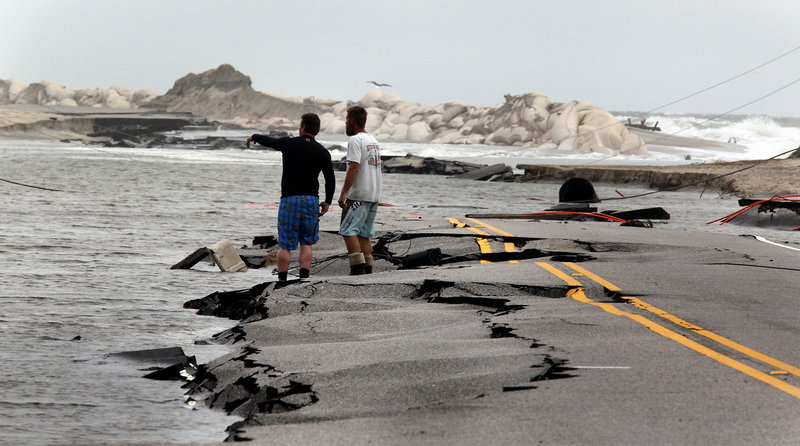With thousands of East Coast residents still cut off by severe flooding in the wake of Hurricane Irene, National Guard members and firefighters were set to begin airlifting food, water and other supplies to some of the stranded.
Meanwhile, more than 3 million utility customers remain without power, and it could be Labor Day weekend before they get the lights turned back on.
On Tuesday, while the rest of the country was moving on from Irene and turning its attention to the upcoming three-day weekend, large swaths of the Northeast remained mired in mud and misery in the wake of the deadly storm.
In New Jersey, search-and-rescue teams helped nearly 600 people stranded by the Passaic River, which was measuring 13 feet above flood stage, according to Reuters.
In Vermont, emergency workers were planning to bring in food and supplies via helicopter; rains and flooding have washed out many roads and bridges, leaving some towns cut off.
And to the south, at least 2,500 residents were stranded on remote Hatteras Island in North Carolina.
Utilities have been working around the clock since the storm ripped up the East Coast over the weekend, stripping power to more than 8 million people. Electricity has since been restored to millions up and down the Atlantic seaboard, but certainly not all.
And that might not change anytime soon.
Power companies have been in triage mode, focusing first on getting power restored to hospitals, police stations and other emergency-service providers. They planned to turn their attention next to schools – classes across the country will be back in session next week. Then, they’ll finally focus on homes.
The storm has been blamed for at least 40 deaths in 10 states, and that number could rise as authorities sift through the debris and assess damages.
The rain and heavy winds also ripped out power lines and power poles – or sent trees crashing down upon them.
Definitive answers about when power will be completely restored were hard to come by Tuesday, given the difficult and hazardous working conditions. Customers in flooded areas have been warned to be prepared for lengthy outages until floodwaters recede and crews can safely enter and restore service.
In North Carolina, Progress Energy reported that restoration efforts have been hampered by severe flooding and by the number of trees on power lines. In remote and low-lying areas, crews have used helicopters, boats and tracked vehicles to assess and access damage.
In New Jersey, where power was out to more than 200,000 PSEG customers, the utility reported that crews were working to dry flooded substations, but that floodwaters are preventing crews from entering a number of other areas.
In Pennsylvania, the Philadelphia-based utility PECO said electrical service was interrupted to about 500,000 by the storm. Service had been restored to more than 332,000 customers by late Monday, and there were hopes that nearly 90 percent of all customers would be back online by today.
Connecticut Light and Power, which experienced its worst power outage in history, reported that crews were working to restore electricity to more than half a million of its 1.2 million customers.
“We expect approx 95 percent of all customer outages to be restored by end of day Friday,” the Long Island Power Authority tweeted. Nearly 400,000 of its customers were still without power.
In Washington, D.C., Pepco Holdings Inc. said it would complete most repairs by Thursday. Baltimore Gas&Electric, Long Island Power Authority in New York and Dominion Resources in Virginia said most of their outages should be restored by Friday.
Dominion Virginia Power and Dominion North Carolina Power reported that power had been restored to about 600,000 of the 1.2 million customers who lost electricity.
“We are working to help ensure that our customers have power for the Labor Day weekend,” Rodney Blevins, Dominion’s vice president of distribution operations, told the Los Angeles Times. “The damage caused by Irene was widespread. Trees and limbs brought down power lines and poles, and storm debris and flooding made it difficult to reach some work areas.”
Blevins said the restoration effort is the company’s second largest, behind Hurricane Isabel from 2003, “when 1.8 million customers were affected and restoration took two weeks.”
Copy the Story LinkSend questions/comments to the editors.



Success. Please wait for the page to reload. If the page does not reload within 5 seconds, please refresh the page.
Enter your email and password to access comments.
Hi, to comment on stories you must . This profile is in addition to your subscription and website login.
Already have a commenting profile? .
Invalid username/password.
Please check your email to confirm and complete your registration.
Only subscribers are eligible to post comments. Please subscribe or login first for digital access. Here’s why.
Use the form below to reset your password. When you've submitted your account email, we will send an email with a reset code.